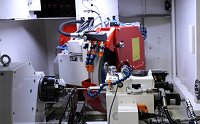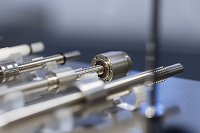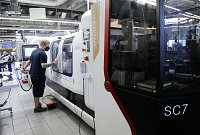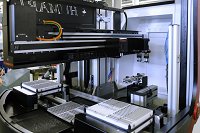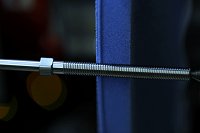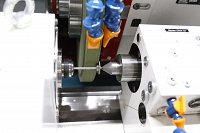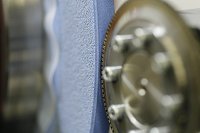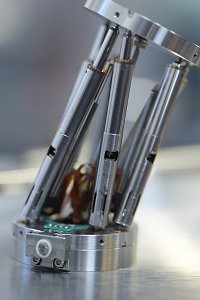Unmanned cylindrical grinding processes for small series
03.03.2022
The internationally operating MPS Micro Precision Systems AG (MPS) consistently uses grinding processes for demanding high-precision components in IT02 tolerance ranges. With a total of seven Studer grinding machines, the company has a cylindrical grinding expertise which is second-to-none. Thanks to automation and process optimization, medium-sized series are also flexibly produced in unmanned processes 24/7. Future projects and prototypes can be brought to market more quickly thanks to a flexible production cell.
MPS, employing a staff of more than 400 employees, is a “Hidden Champion” of a special kind. Back in 1969 RMB (Roulements Miniatures Bienne SA), from which MPS originated, developed components for the Apollo Mission. With 250 employees Biel is the MPS Group’s largest site and has more than 140 turning, milling, grinding, polishing and eroding machines.
Manuel Nercide (Plant Manager): “We have a very varied range of technology, if you want to reduce it to a common denominator, then it’s the manufacture and assembly of complex electromechanical assemblies within the tightest tolerances for high-precision applications in high-end segments.”
Consistent investments in grinding machines
Michael Bazzan (Production Manager): “With seven Studer grinding machines, we currently have a high grinding capacity for producing high-precision components. The grinding machines are matched to our varying lot size spectrum, which ranges from individual component production up to 25,000 pieces per year for some references.”
In accordance with the lot size spectrum, three of the seven Studer machines are currently equipped with an automatic loading system. The focus in the following is on the Studer S33 for the production of recirculating ball screws and a Studer S21 in the area of a flexible production cell (Flex Cell).
Flexible production cell for prototype manufacture
Didier Noirjean – (Flex Cell Manager): “The Flex Cell was recently integrated into cylindrical grinding production as a self-sufficient production unit, in order to set up grinding processes for prototypes and new developments without having to intervene in production. Thanks to this flexible production cell our process from development through to the finished component is much quicker. The decisive factor with the Studer S21 was that it can be changed over very quickly and it can be flexibly configured for different components. Eccentric grinding processes are also possible with the S21. In this regard the Studer S21 is perfectly suited to our requirements.”
While the Flex Cell primarily involves prototypes, series parts are machined on the other six Studer machines. These include recirculating ball screws with a high-precision design.
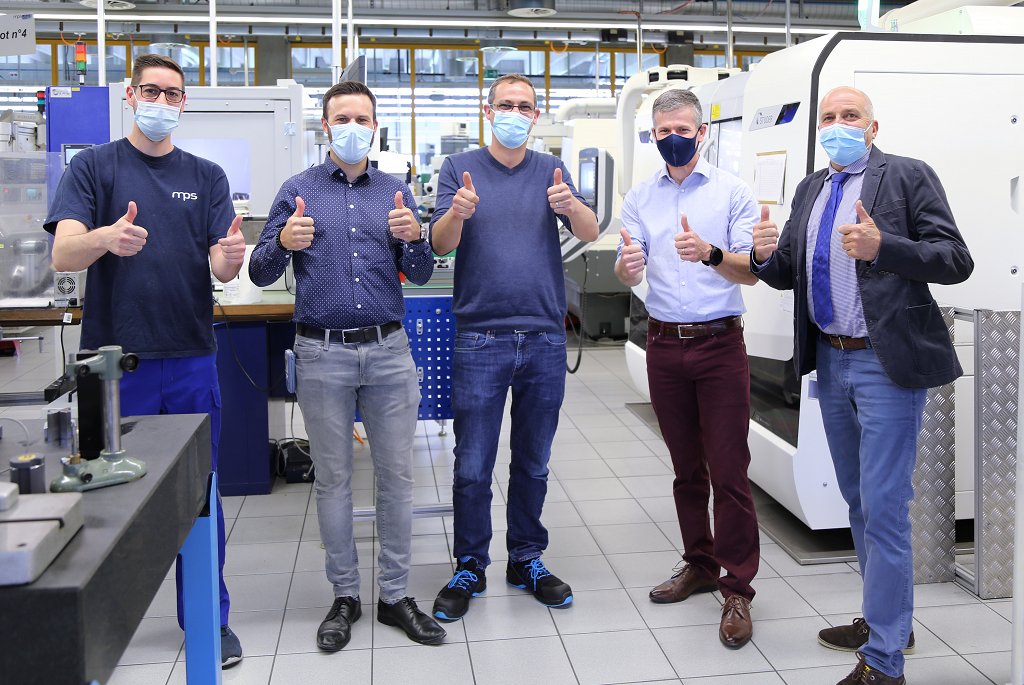
Core competency recirculating ball screws
The smallest recirculating ball screws have a ball diameter of 0.8mm. All components are developed and manufactured in-house by MPS, including the balls. The larger series of screw spindles with gothic-arch thread are produced on a fully automated Studer S33.
Ball-type linear drives for high-precision applications
M. Nercide: “We are involved in research and development with these precision screw spindles. The expertise developed by MPS Microsystems in the extremely gentle and precise positioning of lens groups enables the company to offer powerful alignment systems for optical components such as zoom and laser beam focusing systems.”
Systems designed to customer requirements
MPS Microsystems miniature recirculating ball screws, or ball-type spindles, are made exclusively of stainless steel and are positioned with double nuts, which enable fine adjustment of the axial play. These often customized spindles guarantee virtually smooth movement thanks to the high precision of their ground thread. With regard to customized production: There is a wide range of customized options available for recirculating ball screws.
J. Grosjean: “Such applications require the highest precision and positioning accuracy – 100% backlash-free. And it is precisely here that our spindle systems show their strengths. We grind a so-called gothic-arch thread profile within the tightest tolerance ranges, so that we can reduce the radial clearance and backlash to zero.”
Gothic-arch thread: grinding from solid
The gothic-arch thread form is ground directly from the solid hardened blanks. A macro was developed for these gothic-arch thread forms together with Studer. The grinding parameters can be adapted very quickly to the respective screw spindles with this macro.
U. Weyermann (Regional Sales Manager, Fritz Studer AG): “The Studer S33 used here is an external cylindrical grinding machine with a turret wheelhead. Specifically, the wheelhead used here has two external grinding wheels. One of the two wheels is used for the thread profiling, while the second wheel is generally used for external cylindrical grinding.”
Handling system for unmanned production
In order to produce the medium-sized series cost-effectively, the Humard company developed a flexible handling system for automatic loading and unloading of workpieces in collaboration with MPS and Studer
M. Bazzan: “A crucial factor in the design of the handling system is that it can be quickly adapted to different workpiece geometries, because our lot sizes are variable.”
Typical thread grinding process
The Studer S33 requires less than quarter of an hour for the complete machining of a screw spindle 8 mm in diameter and 120 mm in length. The thread is roughed and finished with the same grinding wheel. The grinding wheel is dressed repeatedly in the micron range throughout the grinding process. More than 1000 screw spindles of this size can thus be ground with one grinding wheel.”
The dressing process with a number of tasks
The grinding wheel dressing process performs an important function during grinding. On the one hand the dimension and form of the grinding wheel are calibrated, and on the other hand the cutting ability of the grinding wheel is defined.
Julien Grosjean (Screw Grinding Manager): “In the case of screw spindles we typically need to dress repeatedly during each production process. Both a diamond and a dressing roll are used for dressing. You can define the roughness of the grinding wheel relatively specifically with the dressing roll, and thus control the grinding process and the surface quality. We have carried out many tests in this regard, until finding the ideal dressing method for the roughing and finishing processes.”
U. Weyermann: “If you consider the complexity of a grinding process and the dimensions of the machines – keyword thermal growth – then producing within IT02 tolerances in unmanned operation is hardly a matter of course. All seven Studer machines deliver exactly the precision and process reliability demanded by MPS on a daily basis. 24/7 production with the IT-02 tolerance ranges that we require is ultimately only possible thanks to the extremely high repeatability precision of our Studer grinding machines.”
Investments reduce production costs
Finally, Manuel Nercide takes a comparative look at the past: “Seven years ago we made between 2000 and a maximum of 5000 spindles, today we produce 50000 spindles a year. We have continually reduced our production costs, not least thanks to investing in modern grinding machines. Seven years ago our production was four times as expensive. From this perspective, investments in modern production equipment are crucial for ensuring long-term viability. Ultimately, our production must satisfy the qualitative and quantitative requirements of our product range. We are perfectly positioned in the cylindrical grinding segment in this regard, not least because of our continued investments.
MPS AG: 400 employees – three locations – four units
MPS Micro Precision Systems AG (MPS) is a Swiss company, which was founded in 1936 with the name RMB (Roulements Miniatures Bienne SA) and was renamed as MPS in 2003. The company group has expertise in the areas of linear ball bearings and miniature recirculating ball screws as well as competencies in development, machining and assembly of electromechanical systems. The electromechanical components and solutions are characterized by reliability, a high level of precision and small dimensions. The demanding markets served by MPS are primarily medical technology, including orthopedics in particular, as well as the watch industry, automation, aerospace, science and optics.
MPS Micro Precision Systems AG employs 400 highly qualified staff and has three locations. The markets are distributed between four units: MPS Microsystems (this report), MPS Watch, MPS Décolletage and MPS Precimed.
In addition, MPS can rely on the know-how of the parent company, the Faulhaber Group, where electromechanical drives systems are concerned.
Photo gallery: Fritz Studer AG
Source: www.studer.com














































